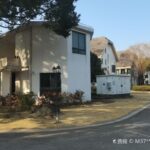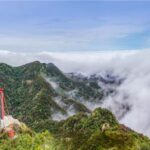Linggu Cave is named after the legendary fairy Linggu, who symbolizes a bumper harvest of grains and lived in seclusion here. It is known as one of the ‘Three Caves (Wonders) of Yixing’ together with Shan Juan Cave and Zhang Gong Cave. Compared with the other two caves, Linggu Cave is known for having’mountains in the cave’. Moreover, it retains more of its original features and there are fewer traces of artificial development. Linggu Cave is located at the southern foot of Shiniu Mountain in the southwest of Yixing urban area. The scenic area is not large. There are seven cave halls in the cave, and visitors need to walk through the entire tour. There is no boat tour. However, it should be noted that the roads in the cave are winding and complex. The stalactites on the top will drip water, and the ground is relatively slippery. Walk carefully. The entrance of Linggu Cave is hidden deep among green bamboos. After entering the cave, the road is winding and deep. But the deeper you go, the wider the cave body becomes. The first cave hall is named ‘Linggu Literature Garden’. The cave hall is relatively small, but there are many small caves on the four walls. Here, there are caves within caves and they are interconnected. It is commonly known as the ‘Crab Cave’. At the end of the cave hall corridor, you can see a stone crevice that is only more than 40 centimeters high. In the past, tourists had to crawl on their stomachs to pass through this crevice to reach the second cave hall. For safety reasons, another path has been opened for passage. The second cave hall is wide and narrow in harmony. The stalactites in the hall are well-arranged and have distinct layers. Moreover, the stone colors are bright. There are landscapes such as ‘Ten Thousand Valleys of Ganoderma’ and ‘Malachite Spring’. On the cave walls, you can also see tiny landscapes such as flowing water, waves, snow-capped mountains, and flying clouds, which are full of fun. The peculiar shapes of the scenery here seem to be artificially arranged. Therefore, this cave hall is called the ‘Linggu Stage’. The third cave hall is located at the bottom of the entire cave. There are huge hanging rocks in the hall. There are five water flows converging on the cave roof, and seven underground currents intersecting at the bottom of the cave. Eventually, they converge into a clear pool under the cave wall, known as ‘All Rivers Converge into the Sea’. This pool is called ‘Tianfu Lingquan’. According to legend, this pool was the place where the ‘Linggu Fairy’ took a bath in the past. The fourth cave hall, ‘Crystal Palace’, is the essence of the entire cave. The scenery here is beautiful. You will see a snow-white large stone curtain at the bottom of the deep valley. It is 17 meters high and more than 5 meters wide. It is shaped like a waterfall and cascades down from the dome with a majestic posture. There is also a karst waterfall spraying out from the dome. A white waterfall hangs down like a rainbow, making a loud noise. The scenery of the fifth cave hall, ‘Treasure Gathering Hall’, is also quite wonderful. Inside, there are stalagmites, stone flowers, stone pillars, and stone curtains of various shapes. They are long and short, thick and thin, full of vitality. There are also beautiful stalactites like brocade. It is very beautiful. In the sixth cave hall, stalactites are hanging high and stalagmites are everywhere. But the shapes of the stalagmites here are either like Avalokitesvara holding a pure bottle, or like Maitreya Buddha with a smiling face all the time, or like the God of Wealth holding a whip and riding a tiger. The shapes of various immortals and Buddhas are vivid and lifelike. Therefore, it has the reputation of ‘Thousand Buddha Mountain’.
The seventh cavern hall’s domed walls are adorned with unpredictable stalactites that take on a dreamlike quality under the illumination of lights, resembling corals, swimming fish, or turtles and snakes, akin to a ‘Dragon Palace and Phoenix Mansion’ within the cave. Additionally, Zhanggong Cave, one of the ‘Three Wonders of Yixing,’ is located six kilometers northeast of Linggu Cave, offering an opportunity for further exploration for those interested.
Opening Hours: The cave is open all year round from 08:00 to 16:00. Preferential Policies: Children under 1.4 meters (inclusive) enter for free; those aged between 6 (exclusive) and 18 (inclusive) receive discounts. Elderly individuals aged 70 (inclusive) and above enter for free; those aged between 60 (inclusive) and 69 (inclusive) receive discounts. Disabled individuals enter for free with a disability certificate. Active-duty military personnel enter for free with an officer’s certificate. Other exceptions include retired cadres with a retirement certificate and group tour guides with a guide certificate and a tour group order, both enter for free. Students with a full-time undergraduate or lower-level student ID receive discounts. Additional Information: The above details are for reference only; please verify specific information with the site on the day of your visit. Service Facilities: Parking Lot – [Linggu Cave Parking], Reference Price: ¥10 per entry; Address: Yangxian Villa, 24 kilometers southwest of Yixing City, Jiangsu Province; Capacity: 200 spaces.








